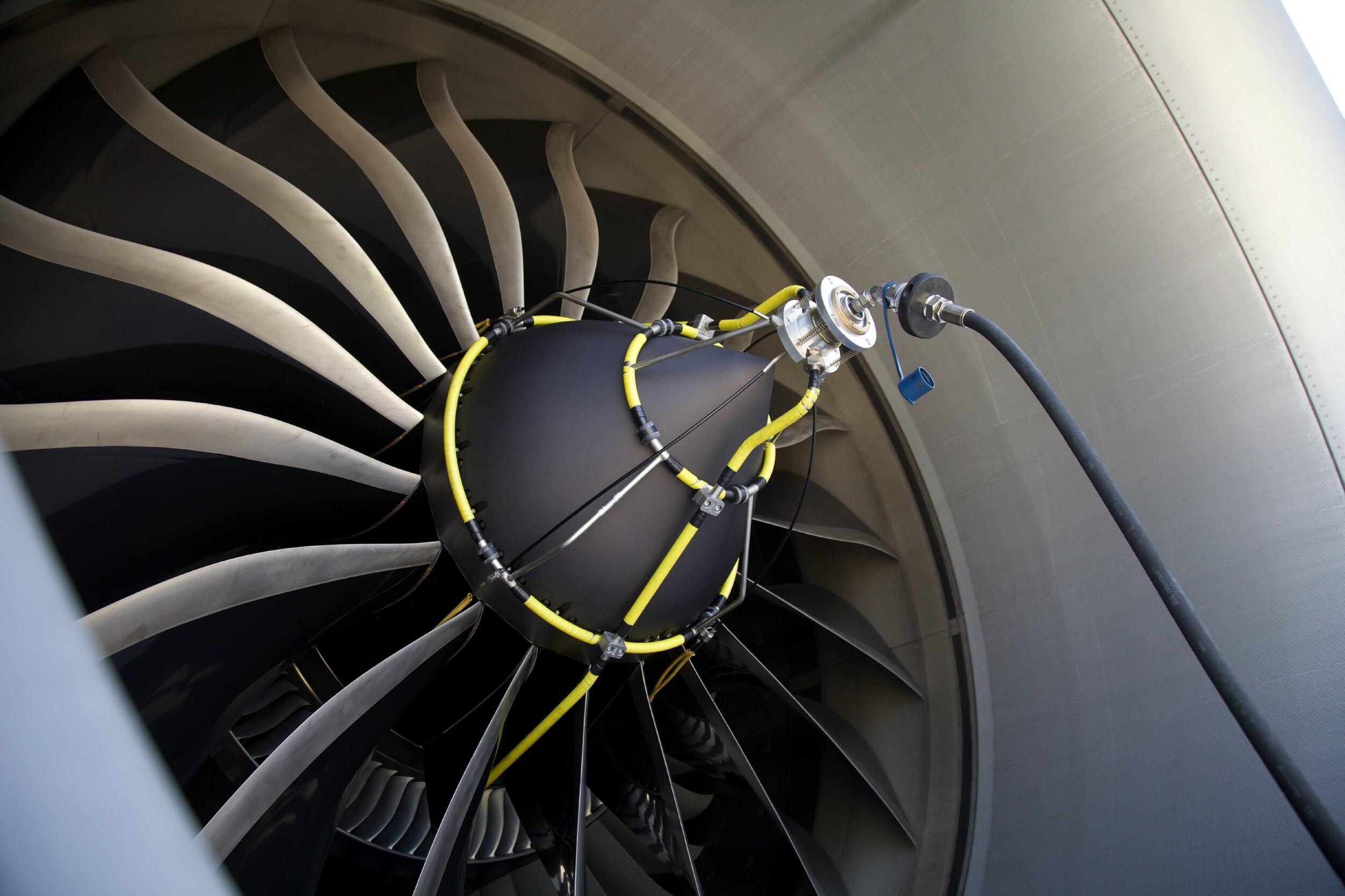Regular Engine Wash Plan For Sustainable MRO | 持続可能なMROのために最適なエンジン洗浄頻度とは

ドイツ航空宇宙センター・DLRの研究者は、民間旅客機のメンテナンスが環境に与える影響を分析した結果、年4回のエンジン洗浄が、排出ガスの削減とオペレーターのコスト削減のバランスが取れていると発表した。
DLRのMRO研究所が実施したこの研究は、航空機メンテナンスのライフサイクルアセスメントに用いるモジュール式フレームワークを開発する広範な取り組みの一環として、まずエンジン洗浄に焦点を当てたものだ。エンジン洗浄は、コンプレッサーブレード、ベーンやステーターなどへの付着物を取り除き、全体的な性能を向上させ、燃費やメンテナンスの負担を軽減することにつながる。
しかし、エンジン洗浄により燃費が1.5%向上し、年間のCO2排出量を大幅に削減することができるとはいえ、オペレーターにとっては大きなコストと時間がかかる作業でもある。DLRの研究者・Antonia Rahn氏は、エアバスA321の最適なエンジン洗浄回数を検証するために「すべての整備工程をひとつひとつ調べ、(エンジン洗浄による)インプットとアウトプットを精査した」と話す。ここで言うインプットとは水や洗浄剤、洗浄機材に必要な電力や洗浄後のエンジン運転に必要な燃料のことで、アウトプットは廃水や排気ガスを指している。
Rahn氏は8月初頭にアメリカ航空宇宙学会(AIAA)がオンライン開催したAviation Forumの場で「調査されたインプットとアウトプットを世界中のエンジンに適用して平準化した。ここで計算された水1リットルあたりの環境負荷は、水を使用する他の整備作業にも適用することができる。1回のエンジン洗浄による環境負荷は、およそ2,000kgのCO2排出に相当することが判明した」と述べた。
この研究では、DLRが独自開発したライフサイクルシミュレーションツールを用い、A321のライフサイクル全体の運用状況を考慮してエンジン洗浄の影響を検証した。「それぞれのフライトは飛行距離や燃料消費率などのパラメーターが異なるため、コストやCO2排出量も違ったものになる。今回、エンジン洗浄による環境インプットが明らかになったことで、機材のライフサイクル全体を通じた経済的・環境的フットプリントを計算することができるようになった」とRahn氏は説明した。
続いて、飛行サイクルを重ねてエンジン内部に付着物が蓄積され、排気ガス温度(EGT)が徐々に高まる状態を考慮し、エンジン洗浄が運航全体に与える影響を検証した。エンジン洗浄を行なっていない場合、9,000サイクル前後で迎える最初の工場整備までにEGTが最大10度程度上昇していることが多い。これと比較して、年に1回エンジン洗浄すると7度程度の上昇に抑えられ、そこで一旦ゼロにリセットされることから、より長期にわたり性能維持と省燃費を実現することができる。
Rahn氏は「オペレーターがエンジン洗浄をすればするほど、理論的には運航コストとCO2排出を削減することができる。しかし、これはエンジン洗浄コストと環境への影響を考慮しなくてはならない」と話す。これに続く研究では、エンジン洗浄の間隔を変えた12のシナリオを検討し、洗浄をおこわない場合と比較した。「洗浄を年1回のみに抑えることが、航空会社にとっては最も経済的という結果になった。ただし、コスト削減にはつながったが、CO2排出量の削減率も最も低かった」と同氏は付け加える。
研究によると、環境面で最高の結果を出すためには年11回のエンジン洗浄が必要になるが、これにはコストがかかりすぎる。Rahn氏は「検証した各シナリオを精査すると、オペレーターにとっては年4回のエンジン洗浄が効果的だと考えられる。この場合、エンジンのライフサイクル全体で5,000トン以上のCO2を削減できる上に、コスト面・運航面への影響を最小限に抑えられる」と締めくくった。
MRO Prospectorで契約情報を検索し、受注機会を発見しましょう
MRO Prospectorは民間機MRO(メンテナンス・修理・オーバーホール)契約の特定、予想される個別MRO案件の確認、将来の航空機およびエンジンのフリート規模を把握するのに役立つオンラインツールです。この製品は、航空会社やMRO事業者とのビジネスチャンスを追求するために、MROマーケットにどのような機会があるのかを知りたい方に向けて作られています。
Four engine washes per year strikes the best balance between reducing emissions and costs to operators say researchers from German aerospace center DLR following an analysis of the environmental impact of maintenance on commercial airliners.
The study, conducted by the DLR’s Institute of Maintenance, Repair and Overhaul (MRO), focused initially on engine washes as part of a broader effort to develop a modular framework for life-cycle assessment of aircraft maintenance. Engine washes remove contaminants from compressor blades, vanes and stators, improving overall performance, reducing fuel burn and maintenance.
However, although the procedure can cut fuel burn by 1.5% and result in significant reductions in annual CO2 emissions, the wash process also represents cost and time to operators. To assess the optimum number of washes for an Airbus A321 “we looked at every single maintenance step and collected the inputs and outputs,” DLR researcher Antonia Rahn said. Inputs for the engine-wash process included water and cleaning agents, plus the energy required for the power-wash equipment and the fuel used to perform an engine run after the process. Outputs were waste-water and emissions.
“We put the inputs and outputs into our global inventory to normalize them,” said Rahn, who was speaking at the American Institute of Aeronautics and Astronautics virtual Aviation Forum in early August. “The environmental impact calculated per liter of water can be reused for other maintenance tasks using water as well. For one engine wash, we calculated an environmental impact of almost 2,000 kgs of CO2 equivalents.”
The DLR study used an in-house life-cycle simulation tool to evaluate the impact of the wash against the context of the A321’s operation over an entire life-cycle. “Every flight event has an individual cost and an emission output depending on different parameters, such as the flight range or the fuel-burn rate. Together with the environmental input for the engine wash, it is now possible to calculate an economic and an environmental footprint over the whole life-cycle of the aircraft,” Rahn said.
The impact of an engine wash on overall operations was then calculated based on how exhaust gas temperature (EGT) gradually increased over flight cycles as contaminants accumulated inside the engine. An engine with no washes will typically experience an EGT rise of up to 10C before the first shop visit at around 9,000 cycles. An engine that was washed once a year, by comparison, would see an EGT rise to around 7C before resetting to zero, thereby improving performance and lowering fuel burn for a longer cumulative period.
“The more often the operator performs an engine wash, the more cost and emissions can be theoretically saved. But this must be weighed against the engine-wash cost and its ecological impact,” Rahn added. The study next looked at 12 scenarios with different intervals between the engine washes and compared them to a case with no washes. “With only one wash per year, we achieved the best economic result for the airline. Here, we got the highest cost savings but also the lowest emission savings.”
To achieve the best environmental result, the study showed an operator would have to wash 11 times per year, but that would be more costly. “Looking at the single differences between every scenario we investigated, [we found] that four engine washes per year would be a good choice for the operator. Because here we can save more than 5,000 tons of CO2 over the entire engine life-cycle with only a very small economic and operational investment.”
